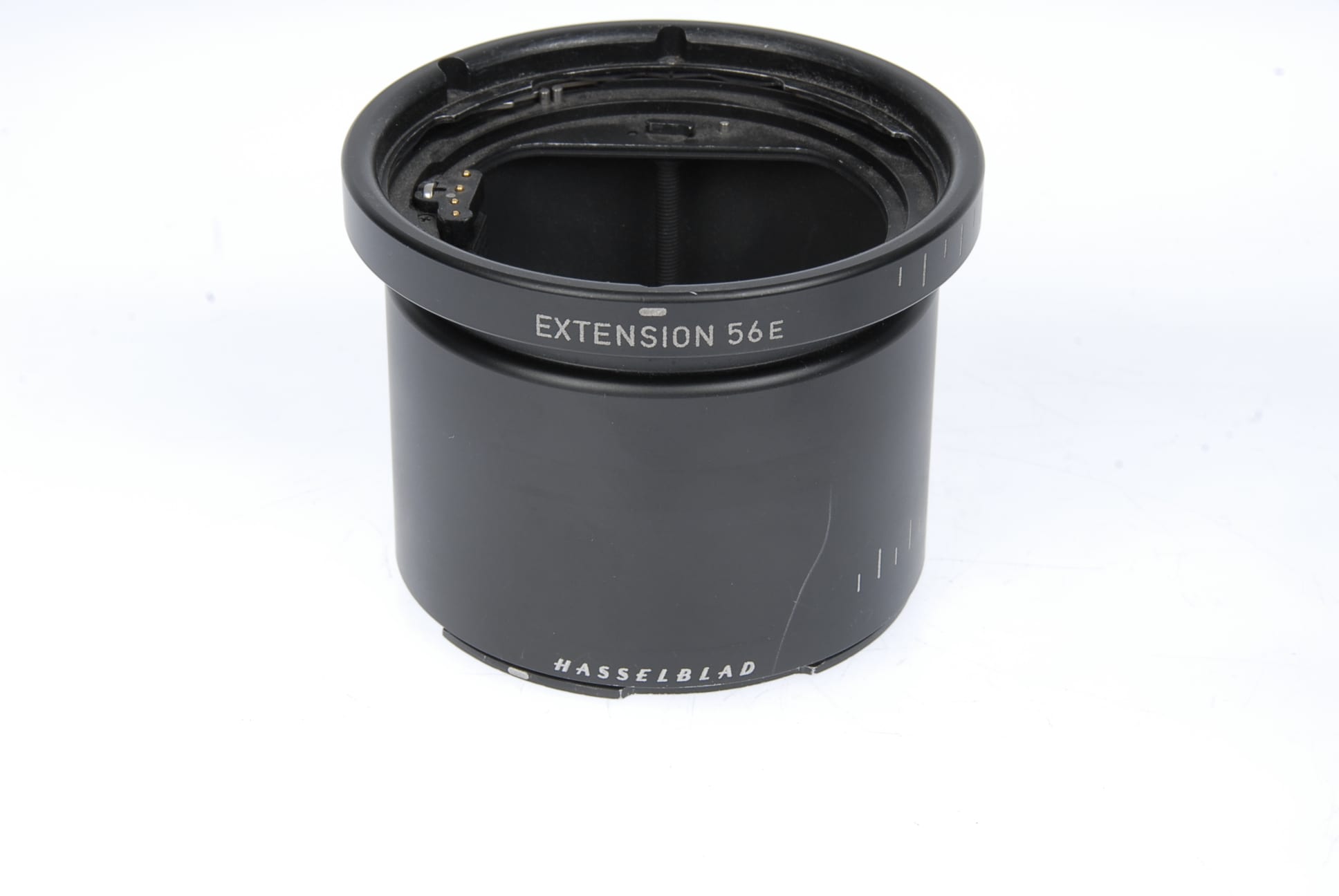Hasselblad Extension Tubes

[fusion_text]Extension tubes are a very common camera accessory. They allow the lens to sit further away from the camera, so that you can focus closer.
Hasselblad extension tubes are more complex than those for other cameras for two principle reasons:
- There is a mechanical linkage between the camera body and the shutter in the lens, known as the drive shaft. This is so that when the shutter release button on the camera is pressed, the shutter in the lens is opened. The mechanical action must be transferred from the body to the lens.
- Some lenses have a databus to communicate electronically with the camera body. The electrical signals must be transferred through the extension tubes. These are marked with an ‘E’ for ‘electronic on the 16E, 32E and 56E tubes. Electrical contacts can be found on the 200 series cameras and the CFE/TCC lenses.
[/fusion_text][one_half last=”no” spacing=”yes” center_content=”no” hide_on_mobile=”no” background_color=”” background_image=”” background_repeat=”no-repeat” background_position=”left top” border_position=”all” border_size=”0px” border_color=”” border_style=”” padding=”” margin_top=”” margin_bottom=”” animation_type=”” animation_direction=”” animation_speed=”0.1″ class=”” id=””][imageframe lightbox=”no” lightbox_image=”” style_type=”none” hover_type=”none” bordercolor=”” bordersize=”0px” borderradius=”0″ stylecolor=”” align=”center” link=”” linktarget=”_self” animation_type=”0″ animation_direction=”down” animation_speed=”0.1″ hide_on_mobile=”no” class=”” id=””]  [/imageframe][fusion_text]
[/imageframe][fusion_text]
Drive Shaft in an Extension Tube
[/fusion_text][/one_half][one_half last=”yes” spacing=”yes” center_content=”no” hide_on_mobile=”no” background_color=”” background_image=”” background_repeat=”no-repeat” background_position=”left top” border_position=”all” border_size=”0px” border_color=”” border_style=”” padding=”” margin_top=”” margin_bottom=”” animation_type=”” animation_direction=”” animation_speed=”0.1″ class=”” id=””][imageframe lightbox=”no” lightbox_image=”” style_type=”none” hover_type=”none” bordercolor=”” bordersize=”0px” borderradius=”0″ stylecolor=”” align=”center” link=”” linktarget=”_self” animation_type=”0″ animation_direction=”down” animation_speed=”0.1″ hide_on_mobile=”no” class=”” id=””]  [/imageframe][fusion_text]
[/imageframe][fusion_text]
Databus Electrical Contacts in an ‘E’ or TCC Extension Tube
[/fusion_text][/one_half][fusion_text]Words of Caution!
It is really easy to get a body and lens jammed when using extension tubes. The jamming is generally caused by the drive shaft being misaligned between the body, lens and extension tube. If you are using more than one extension tube, you should be even more careful.
You can significantly reduce this by following a few simple rules:
- Examine the extension tube for damage, and that the shutter release red dot is aligned before use. See below.
- Always attach the extension tube to the body, then the lens to the body.
- If using more than one tube, attach them individually.
- The lens’s shutter must be cocked before attaching. You can tell by checking to see if the red dot is aligned.
- Ensure that the camera is wound before attaching the extension tubes.
- Never remove the tube and lens together. Dismantling is the reverse of assembly.
[/fusion_text][imageframe lightbox=”no” lightbox_image=”” style_type=”none” hover_type=”none” bordercolor=”” bordersize=”0px” borderradius=”0″ stylecolor=”” align=”center” link=”” linktarget=”_self” animation_type=”0″ animation_direction=”down” animation_speed=”0.1″ hide_on_mobile=”no” class=”” id=””]  [/imageframe][fusion_text]
[/imageframe][fusion_text]
Red Dot Aligns with Screw Thread
[/fusion_text][fusion_text]Diagrammatic explanation from a Hasselblad manual
This diagram is included within the Hasselblad manual for the ‘E’ extension tubes. It includes a huge about of information:
E – Extension, in mm
R – Degree of magnification
D – Depth of field at f11
L – Length of sides of the square subject area
EV – Light reduction (EV steps)
The other extension tube manuals have similar data and cover the other lenses made. However, they are not as clear. The manuals are available at the end of this article, for reference.[/fusion_text][imageframe lightbox=”no” lightbox_image=”” style_type=”none” hover_type=”none” bordercolor=”” bordersize=”0px” borderradius=”0″ stylecolor=”” align=”center” link=”” linktarget=”_blank” animation_type=”0″ animation_direction=”down” animation_speed=”0.1″ hide_on_mobile=”no” class=”” id=””]  [/imageframe][fusion_text]
[/imageframe][fusion_text]
Diagram from Hasselblad Manual
[/fusion_text][fusion_text]It is best described by Hasselblad:
“The different colors are used to separate different tubes or tube combinations. The l.h. end of the blue/red line represents the lens focused at infinity, and the length of the line shows the extension obtained by the lens’s focusing means.
How to use the diagram:
Example 1:
Makro-Planar 4/120mm lens: extension tube 32E.
- Select the lens type in the far l.h. column.
- Select the tube or combination of tubes you are using.
- Follow the thin vertical “tube” line until it crosses the blue/red “lens” line.
- Read the applicable data from the information in the lens field. At the line crossing in the lens field you can read:
Magnification R = approx. 0.27
Depth-of-field D = 25 mm
Area covered L = approx. 220 x 220 mm
EV reduction EV = 0.5 step
Example 2:
Sonnar FE 2,8/150 mm lens: 150x 150 mm coverage.
- Select the lens type in the far l.h. column.
- Follow the L row to 150.
- Read the applicable data from the information in the lens field. There you have the choice of the combination of tubes 32E and 16E with the lens focused (the red line) or the tube 56E with the lens at infinity (the start of blue line)
Magnification R = approx. 0.37
Depth-of-field D = approx. 15 mm
EV reduction EV = 1 step “[/fusion_text][fusion_text]PDF Copies of the Hasselblad Manuals
21mm & 55mm Extension Tubes – 1959
21mm & 55mm Extension Tubes – 1970
16mm & 32mm Extension Tubes – 1977
8mm, 16E, 32E & 56E Extension Tubes – 1990[/fusion_text]
